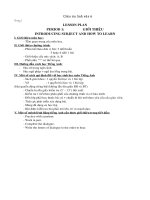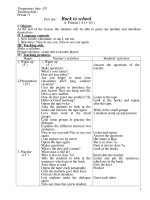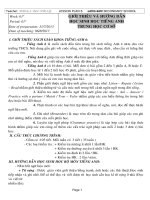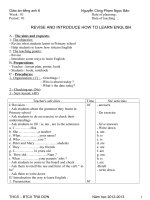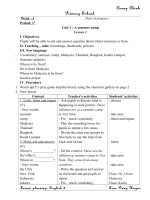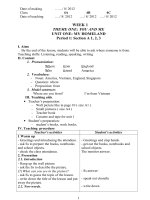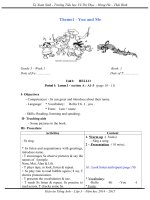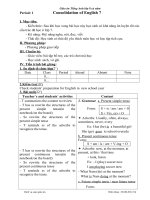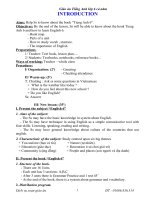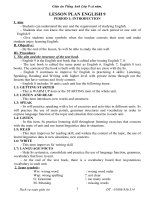GIÁO án TIẾNG ANH lớp 5 cả năm 35 TUẦN THEO CÔNG văn 2345 của bộ GIÁO dục bản word
Bạn đang xem bản rút gọn của tài liệu. Xem và tải ngay bản đầy đủ của tài liệu tại đây (1.05 MB, 410 trang )
Week: 1
Period: 1
UNIT 1: WHAT’S YOUR ADDRESS?
Lesson 1 (1-2-3)
I. Objectives:
By the end of the lesson, Ss will be able to:
1. Knowledge:
- Ask and answer questions about the other speaker’s address.
- Sentence Patterns: What’s your address? – It’s _______.
- Vocabulary: numbers, address, lane, road, floor, flat, tower
2. Skills:
- Listening and speaking.
3. Attitude/ Quality:
- Be confident in communicating with friends/ teachers.
- Love people and their hometown.
4. Forming competence:
- Co-operation (ready to help friends in pair work/ groupwork).
- Self-study ( can perform individual tasks and solve problems by themselves.
- Use language to ask and answer questions about someone’s address.
II. Teaching aids:
- CDs players, stereo, book.
III. Methods:
- Communicative approach, group Ss and T's activities, play as a character, teaching
methods with game, teaching methods by visual, teaching methods by practising,
discussion group, technical present....
IV. Procedures
Content
Teacher’s activities
Students’ activities
A. Warm up
(5’)
- Greet the class by saying Hello/Hi. ?
- Greet and respond each
- Ask pupils to respond with Hello/Hi.
other
I’m fine. Thank you. And you?
- Lead into new lesson
B. New lesson 1. Look, listen and repeat. (10’)
(30’)
- Ask pupils to look at the picture to
- Guess
point at each character and elicit their
answers to the questions:
Who’s this? What’s his/her name? Is
he/she a newcomer? Where’s he/she
from?
- Play the recording for pupils to listen
- Listen carefully
to the tape
- Play the recording again and ask
- Listen and repeat
them to repeat a few times.
- Explain new words: address, tower.
- Say aloud the words, then ask pupils
- Repeat the words.
to repeat the words a few times
- Have pupils write down the new
- Write down
words into their notebook
- Ask pupils to practice in pairs to
practice the dialogue.
- Check some pairs. Ask other pupils
- Work in pairs.
to give comments.
- Give comments.
- Listen and comment
2. Point and say. (20 minutes)
- Tell pupils that they are going to
- Listen to the T's
practice asking and answering
instruction.
questions about one’s address using:
* Structure: What’s your address?
It’s……
- Introduce new words: lane, village,
flat, street
- Say aloud for pupils to repeat it.
- Repeat.
- Ask pupils to write down the new
- Write down.
words and the structure in their
notebook.
- Call on an open pair to the front of
- Listen
the class to give a model practice.
- Get pupils to work in pairs.
- Work in pairs
- Call some pairs to practice in front of
- Listen and comment
the class
- Give feedback and correct mistakes
of pronunciation.
3. Let’s talk
- Tell the class that they are going to
- Listen to the T's
practice further by asking and
instruction.
answering questions about addresses.
- Get pupils time to work in groups of
- Practice in groups
four to ask each other’s addresses,
using the structure.
- Invite a few pupils to repeat their
- Listen and comment
interviews to the class.
- Give feedback
C. Production - Summary the lesson
(3’)
- Tell pupils to read the part 1 again.
D. Homework - Do exercises in work book, learn by
(2’)
- Listen and remember
- Take note.
heart the new words and the structure.
*********************************************************************
Week: 1
Period: 2
UNIT 1: WHAT’S YOUR ADDRESS?
Lesson 1 (4-5-6)
I. Objectives:
By the end of the lesson, Ss will be able to:
- Ask and answer questions about someone’s address
1. Knowledge:.
- Listen and complete the addresses.
- Read and complete the gapped paragraph, using the words provided.
- Sing the song The wheels on the bus.
- Sentence Patterns: Revision
- Vocabulary: The song lyrics
2. Skills:
- Listening and speaking.
3. Attitude/ Quality:
- Be confident in communicating with friends/ teachers.
- Love people and their hometown.
4. Forming competence:
- Co-operation (ready to help friends in pair work/ groupwork).
- Self-study ( can perform individual tasks and solve problems by themselves.
- Use language to ask and answer questions about someone’s address.
II. Teaching aids:
- CDs players, stereo, book.
III. Methods:
- Communicative approach, group Ss and T's activities, play as a character, teaching
methods with game, teaching methods by visual, teaching methods by practising,
discussion group, technical present....
IV. Procedures
Content
A. Warm up
(5’)
Teacher’s activities
- Invite three pupils to act out the story
Students’ activities
- Listen and comment.
in activity 1
- Lead into new lesson.
B. New lesson 4. Listen and complete. (10 minutes)
(30’)
- Tell pupils that they are going to
- Listen to the T's
listen to the recording and complete
instruction.
the addresses.
- Give time for pupils to read the
- Read and guess
sentences and guess the missing words
they need to fill the gaps.
- Play the recording the second time
- Listen and tick.
for pupils to listen and complete.
- Ask pupils to give answers
- Give the answers.
- Play the recording again for pupils to
- Listen and check
listen and check
- Give correct answers.
Key: 1. 208
2. 321
3. White Street
4 the second floor
5. Look and write. (10 minutes)
- Tell pupils that they are going to read
- Listen to the T's
and fill the gaps with street, address,
instruction.
live or from.
- Give time for pupils to read the
- Read
sentences. Tell them to focus on the
context to select the appropriate words
from the box.
- Ask pupils to do the task.
- Do the task
- Go around and offer help, if
necessary.
- Ask pupils to give answers and other
- Listen and comment
pupils to give comments.
- Give correct answers.
*Key: 1 from 2 lives 3 address
4 Street
6. Let’s sing (10 minutes)
- Tell pupils that they are going to sing
- Listen to the T's
the The wheels on the bus song.
instruction.
- Get pupils to read the lyrics in
silence. Check their comprehension.
- Read
- Play the recording all the way
through for pupils to get familiarized
- Listen
with the pronunciation, the stress, the
- Listen and repeat.
rhythm and the intonation of the song.
- Play the recording again, pausing
- Listen and repeat once
after each line for pupils to repeat.
more.
- Play the recording once more for
pupils to repeat the whole song.
- Then have them practice in groups.
- Work in groups
- Call on some groups to sing the song
- Sing and clap the hands
in front of the class. The rest of the
at rhythms.
class clap their hands at rhythms.
Summary the lesson
C. Production - Tell pupils to do exercises in work
(3’)
book
D. Homework - Ask pupils to practice singing at
(2’)
- Listen and remember.
- Take note
home
*********************************************************************
Week : 1
Period: 3
UNIT 1: WHAT’S YOUR ADDRESS?
Lesson 2 (1-2-3)
I. Objectives:
By the end of the lesson, Ss will be able to:
1. Knowledge:
- Ask and answer questions about what a place like.
- Sentence Patterns: What’s the _____ like? − It’s ______.
- Vocabulary: city, village, town, island, big, busy, far, quiet, large, crowded, small,
pretty
2. Skills:
- Listening and speaking
3. Attitude/ Quality:
- Be confident in communicating with friends/ teachers.
- Show pride and love to your hometown and respects to other’s hometown.
4. Forming competence:
- Co-operation (ready to help friends in pair work/ groupwork).
- Self-study ( can perform individual tasks and solve problems by themselves).
- Use language to talk about what a village/ town/ city is like.
II. Teaching aids:
- CDs players, stereo, book.
III. Methods:
- Communicative approach, group Ss and T's activities, play as a character, teaching
methods with game, teaching methods by visual, teaching methods by practising,
discussion group, technical present....
IV. Procedures
Content
A. Warm up
(5’)
Teacher’s activities
- Get the class to the The wheels on the
Student’s activities
- Sing the song
bus song.
- Lead into new lesson
B. New lesson 1. Look, listen and repeat. (10’)
(30’)
- Introduce picture and ask some
- Look, listen and answer
questions about the situations in the
the questions.
picture:
? What’s his name?
? Who’s he talking with?
? Where does he live?
? What’s the village like?
- Explain new word: mountain.
- Say aloud the word, then ask pupils
- Listen and repeat
to repeat the word a few times
- Play the recording and ask pupils to
- Listen.
look at their book and listen to the tape
- Play the recording again and ask
- Listen and repeat
them to repeat a few times.
- Have pupils write down the new
- Write
words into their notebook
- Ask pupils to work in pairs to
- Work in pairs.
practice the dialogue.
- Go around and check pupils can
repeat and understand the dialogue.
- Check some pairs.
- Practice in front of
- Others give comments.
class.
2. Point and say. (13 minutes)
- Give comments
- Tell the class that they are going to
- Listen to the T's
practice the questions and answers
instruction.
describing a place, using:
* Structure: What’s the ... like? It’s ...
- Say aloud the structure for pupils to
- Listen and repeat
repeat.
- Call some pupils to read aloud the
- Read aloud the structure
structure.
- Explain new words: far, busy, quiet,
- Read the new words
crowded and pretty.
- Say aloud the words, then ask pupils
- Write down
to repeat the words a few times
- Ask pupils to write down the
- Listen
structure into their notebook.
- Call on an open pair to the front of
- Work in pairs
the class to
give a model practice.
- Ask pupils to work in pairs.
- Call some pairs to practice in front of
the class.
- Give feedback and correct mistakes
of pronunciation
- Listen and comment
3. Let’s talk (7 minutes)
- Tell the class that they are going to
- Listen to the T's
practice further by asking and
instruction.
answering questions about where they
live.
- Practice in pairs
- Set a time limit for the class to
practice talking in pairs, answer the
questions with information about
themselves.
- Call a few pairs to act out the
dialogue in front of the class.
- Give feedback.
- Listen and comment
C. Production Summary the lesson
(3’)
- Tell pupils to read the part 1 again.
D. Homework - Do exercises in workbook, learn by
(2’)
- Listen
- Take note
heart the new words and the pattern.
*********************************************************************
Week: 1
Period: 4
UNIT 1: WHAT’S YOUR ADDRESS?
Lesson 2 (4-5-6)
I. Objectives:
By the end of the lesson, Ss will be able to:
1. Knowledge:
- Ask and answer questions about what a village/ town/ city is like.
- Listen, and circle the letters showing the correct phrases completing the sentences.
- Write about themselves, using the guiding questions.
- Play the game Spot the difference.
- Sentence Patterns: Revision
- Vocabulary: Revision
2. Skills:
- Listening, writing and speaking
3. Attitude/ Quality:
- Be confident in communicating with friends/ teachers.
- Show pride and love to your hometown and respects to other’s hometown.
4. Forming competence:
- Co-operation (ready to help friends in pair work/ groupwork).
- Self-study ( can perform individual tasks and solve problems by themselves).
- Use language to talk about what a village/ town/ city is like.
II. Teaching aids:
- CDs players, stereo, book.
III. Methods:
- Communicative approach, group Ss and T's activities, play as a character, teaching
methods with game, teaching methods by visual, teaching methods by practising,
discussion group, technical present....
IV. Procedures
Content
A. Warm up
(5’)
Teacher’s activities
- Play game: Slap the board, using:
Student’s activities
- Play game
city, village, town, island, big, busy,
quiet, large, crowded and small
- Lead into new lesson
B. New lesson 4. Listen and circle a or b. (10‘)
(30’)
- Tell the class that they are going to
- Listen to the T's
listen and circle a or b to complete the
instruction.
sentences.
- Ask pupils to read the sentences and
- Read and guess
guess the correct answers.
- Play the recording twice for pupils to
- Listen and tick
listen and tick
- Have pupils exchange the answers
- Work in pairs
with their partners.
- Play the recording again for pupils to
listen and check
- Give correct answers
- Listen and check.
* Key: 1 a
2b
3b
4a
5. Write about you. (10 minutes)
- Tell the class that they are going to
- Listen to the T's
write about where they live and who
instruction.
they live with.
- Give pupils a few seconds to read the - Read the questions
questions in silence and check their
understanding.
- Do the task
- Give pupils time to do the task.
- Call an open pair to read aloud their
- Read aloud
answers in front of the class.
- Ask other pupils to give feedback.
- Other pupils give
- Give the correct answers.
feedback
* Key:
6. Let’s play(10 minutes)
- Tell pupils that they are going to play
- Listen to the T's
the game Spot the difference.
instruction.
- Tell pupils that they have to compare
the two pictures and find out the five
details which are different.
- The first pupil who finds out all the
- Find out the five details
different details is the winner.
which are different.
*Key: Picture b is different from
Picture a in the following ways:
• There is one more car in the road
• There is a woman in front of the
yellow building.
• The sign next to the yellow building
is blue, and it reads BUS STOP.
• There is no logo of pills on the
pharmacy.
• There is a boy behind the father and
daughter.
C. Production - Summary the lesson
(3’)
- Listen and remember
- Tell pupils to do exercises in work
D. Homework book at home
- Take note
(2’)
*********************************************************************
Week: 2
Period: 5
UNIT 1: WHAT’S YOUR ADDRESS?
Lesson 3 (1-2-3)
I. Objectives.
By the end of the lesson, students will be able to:
1. Knowledge:
- Pronounce two-syllable words with the stress on the first syllable: 'city, 'village,
'mountains, 'tower.
- Listen and circle the letters showing the correct words filling the gapped sentences.
- Say the chant Where do you live?
- Sentence Patterns: Revision
- Vocabulary: Revision
2. Skills:
- Listening and speaking.
3. Attitude/ Quality:
- Be confident in communicating with friends/ teachers.
- Show pride and love to your hometown and respects to other’s hometown.
4. Forming competence:
- Co-operation (Ready to help friends in pair work/ groupwork).
- Self-study ( can perform individual tasks and solve problems by themselves).
- Use language to talk about what a village/ town/ city is like, do the listening task and
read the chant.
II. Methods:
- Communicative approach, group Ss and T's activities, play as a character, teaching
methods with game, teaching methods by visual, teaching methods by practising,
discussion group, technical present....
III. Preparation.
1. Teacher’s preparation: CDs player, stereo, book.
2. Student’s preparation: Students’ aids: books, notebooks, workbooks.
IV. Procedures
Content
A. Warm up
(5’)
Teacher’s activities
- Have the class to play game: Slap the
Student’s activities
- Play game
board, using the phrases learnt in the
previous lessons.
- Lead into new lesson
B. New lesson
(30’)
1. Listen and repeat. (10 minutes)
- Tell the class that they are going to
- Listen to the T's
practice saying two-syllable words with
instruction.
the stress on the first syllable.
- Put the words on the board with
the stress marks and say them a
few times.
- Listen and repeat
- Play the recording for pupils to listen
and repeat.
- Read individual
- Ask pupils to read the words and
sentences until pupils feel confident.
- Listen and comment
- Get some pupils to say the words and
sentences in front of the class.
- Correct mistakes of pronunciation.
2. Listen and circle a or b. Then say the
sentences aloud. (10 minutes)
- Listen to the T's
- Tell pupils that they are going to listen
instruction.
and circle a or b to complete the
sentences.
- Read and guess
- Give them a few seconds to read the
sentences in silence and guess the
words to fill the gaps.
- Play the recording twice for pupils to
- Listen and circle.
listen, circle a or b.
- Play the recording again for pupils to
- Listen and check, then
listen and check. Ask some pupils to
read the sentences aloud.
read the sentences aloud.
- Give the correct answers.
* Key: 1 b
2a
3a
3. Let’s chant (10 minutes)
- Tell pupils that they are going to say
- Listen to the T's
the chant: Where do you live?
instruction.
- Play the recording all the way through
- Listen and follow in
for pupils to listen and follow in their
the book
books.
- Play the recording again, pausing after - Listen and repeat
each line for pupils to repeat.
- Play the recording once more for
- Listen, repeat and do
pupils to repeat the whole chant, show
the actions
pupils how to chant and do the actions
- Get pupils to work in pairs to practice
- Chant in pairs
chanting and doing the action.
-Invite some pairs to say the chant and
- Chant in front of class
do actions in front of the class
- Give feedback.
- Ask the whole class to say the chant
- Say and clap along to
and clap along to the rhythm of the
the rhythm of the chant
C. Production chant.
(3’)
D. Homework
- Listen and remember.
Summary the lesson.
- Take note
(2’)
- Tell pupils to practice chanting again
at home.
********************************************************************
Week: 2
Period: 6
UNIT 1: WHAT’S YOUR ADDRESS?
Lesson 3 (4-5-6)
I. Objectives.
By the end of the lesson, students will be able to:
1. Knowledge:
- Pronounce correctly the stress of the two syllable nouns
- Read the paragraph, and tick the sentences Y (Y) or N (No).
- Write about their friends, using the guiding questions.
- Draw a house, write its address, and present the drawing to the class.
- Colour the stars showing their English competences.
2. Skills: Listening, reading, writing and speaking.
3. Attitude/ Quality:
- Be confident in communicating with friends/ teachers.
- Love people and their hometown.
4. Forming competence:
- Co-operation (Ready to help friends in pair work/ groupwork).
- Self-study ( can perform individual tasks and solve problems by themselves).
- Use language to talk about what a village/ town/ city is like, do the listening task and
read the chant.
II. Methods:
- Communicative approach, group Ss and T's activities, play as a character, teaching
methods with game, teaching methods by visual, teaching methods by practising,
discussion group, technical present....
III. Preparation.
1. Teacher’s preparation: CDs player, stereo, book.
2. Student’s preparation: Students’ aids: books, notebooks, workbooks.
IV. Procedures
Content
A. Warm up
(5’)
Teacher’s activities
Student’s activities
- Have the class say the chant: Where
- Chant
do you live?
- Lead into new lesson
B. New lesson
(30’)
4. Read and tick Yes or No. (10’)
- Tell pupils that they are going to read
- Listen to the T's
the texts and tick Yes or No.
instruction.
- Give a few seconds for pupils to read
- Read in silence
the sentences and underline the key
words/ phrases in silence.
- Ask pupils to read the text again and
- Do the task
do the task
- Set a time limit for pupils to do the
task.
- Go around the class and offer help, if
- Works in pairs
necessary.
- Have pupils exchange the answers
- Write on the board.
with their partners
- Call four pupils to write their answers
on the board.
- Give feedback and correct mistakes
* Key: 1 N
2Y
3N
4Y
5Y
5. Write about your friends. (10’)
- Tell pupils that they are going to write
- Listen to the T's
about one of their friends.
instruction.
- Give pupils time to read the questions
- Do the task
and write the answers in their
notebooks.
- Go around offering help, if necessary.
- Ask pupils to write their answers on
the board.
- Write the answers.
- Give feedback.
Key:
6. Project (10 minutes)
- Tell pupils that they are going to do a
- Listen to the T's
drawing project.
instruction.
- Give pupils time to work in groups to
- Practice in pairs
discuss the house they are going to
draw, and its address.
- Invite a few groups to present their
- Present in front of
drawings to the class and talk about
class.
them.
- Give feedback
7. Colour the stars.
- Have the class read the statements and
- Colour the stars.
check their comprehension
- Give the time to colour the star and
invite a few pupils to read the statement
aloud
- Give further support to pupils who
find it difficult to achieve certain
objectives.
C. Production - Summary the lesson
- Listen and remember
(3’)
D. Homework - Tell pupils to do exercises in
(2’)
- Take note
workbook.
*********************************************************************
Week: 2
Period: 7
UNIT 2: I ALWAYS GET UP EARLY. HOW ABOUT YOU?
Lesson 1 (1-2-3)
I. Objectives:
By the end of the lesson, Ss will be able to:
1. Knowledge:
- Ask and answer questions about someone’s daily routine
- Sentence Patterns: What do you do _____?
I always / usually / often / sometimes _____.
- Vocabulary: always brush my teeth, usually do morning exercise, often cook dinner,
sometimes watch TV
2. Skills:
- Speaking skill
3. Attitude/ Quality:
- Be confident in communicating with friends/ teachers.
- Should have good habits.
- Love themselves.
4. Forming competence:
- Co-operation (ready to help friends in pair work/ groupwork).
- Self-study (can perform individual tasks and solve problems by themselves).
- Use language to talk about daily routine.
II. Methods: Communicative approach, group Ss and T's activities, play as a
character, teaching methods with game, teaching methods by visual, teaching methods
by practising, discussion group, technical present....
III. Preparation.
1. Teacher’s preparation: CDs player, stereo, book.
2. Student’s preparation: Students’ aids: books, notebooks, workbooks.
IV. Procedures
Content
A. Warm up
(5’)
Teacher’s activities
- Get pupils to sing the song: The wheel
Student’s activities
- Sing the song
on the bus.
- Lead into new lesson
B. New lesson
(30’)
1. Look, listen and repeat. (10‘)
- Ask pupils to look at the picture to
- Look at the pictures
point at each character and elicit their
and give the answers
answers to the questions:
Who’s this? What’s he doing? Who’s he
talking with online? What does he do in
the morning? What does he do after
school/in the afternoon?
- Play the recording for pupils to listen
- Listen carefully
to the tape
- Play the recording again and ask them
- Listen and repeat
to repeat a few times.
- Explain new words: address, tower.
- Say aloud the words, then ask pupils to
- Repeat the words.
repeat the words a few times
- Have pupils write down the new words
- Write down
into their notebook
- Ask pupils to practice in pairs to
- Work in pairs.
practice the dialogue.
- Go round and check pupils can repeat
and understand the dialogue.
- Check some pairs. Ask other pupils to
- Practice in front of
give comments.
class. Others gives
- Give comments.
comments
2. Point and say. (20 minutes)
- Tell the class that they are going to
- Listen to the T's
practice asking and answering questions
instruction.
about someone’s daily routines, using:
* Structure:
What do you do in the
morning/afternoon/evening?
I always/usually/often/ sometimes ...
- Introduce new words: brush my teeth),
often, do morning exercise, cook dinner,
sometimes, never.
- Say aloud for pupils to repeat it.
- Repeat.
- Ask pupils to write down the new
- Write down.
words and the structure in their
notebook.
- Work in pairs
- Have pupils practice asking and
- Practice in front of the
answering in pairs.
class
- Call some pairs to practice in front of
the class
- Give feedback and correct mistakes of
pronunciation.
3. Let’s talk
- Listen to the T's
- Tell the class that they are going to
instruction.
practice further by asking and answering
questions about someone’s daily
- Practice in pairs
routines.
- Get pupils time to work in pairs to ask
- Act out in front of
and answer, using the structure.
class
- Invite a few pairs to act out their
C. Production conversations in front of the class.
(3’)
- Give feedback summary the lesson
- Listen and remember
- Tell pupils to read the part 1 again.
D. Homework - Do exercises in work book, learn by
(2’)
- Take note.
heart the new words and the structure.
*********************************************************************
Week : 2
Period: 8
UNIT 2: I ALWAYS GET UP EARLY. HOW ABOUT YOU?
Lesson 1 (4-5-6)
I. Objectives:
By the end of the lesson, Ss will be able to:
1. Knowledge:
- Ask and answer questions about someone’s daily routine
- Listen and tick the correct pictures.
- Read and complete the gapped paragraph with the words provided.
- Sing the song This is the way we do things.
- Sentence Patterns: Revision
- Vocabulary: The song lyrics
2. Skills:
- Speaking, listening and reading skill
3. Attitude/ Quality:
- Be confident in communicating with friends/ teachers.
- Should have good habits.
- Love themselves.
4. Forming competence:
- Co-operation (ready to help friends in pair work/ groupwork).
- Self-study (can perform individual tasks and solve problems by themselves).
- Use language to talk about daily routine.
II. Methods: Communicative approach, group Ss and T's activities, play as a
character, teaching methods with game, teaching methods by visual, teaching methods
by practising, discussion group, technical present....
III. Preparation.
1. Teacher’s preparation: CDs player, stereo, book.
2. Student’s preparation: Students’ aids: books, notebooks, workbooks.
IV. Procedures
Content
A. Warm up
(5’)
Teacher’s activities
- Invite three pupils to act out the story in
Students’ activities
- Act out in front of class.
activity 1.
- Ask and answer.
- Call two pairs of pupils to ask and
answer questions about their daily
routines, using:
What do you do in the morning/
afternoon/ evening? I always/ usually/
often/ sometimes ...
B. New
- Lead into new lesson.
- Listen to the T's
4. Listen and tick. (10 minutes)
instruction.
lesson
- Tell pupils that they are going to listen
(30’)
to the recording and tick the correct
- Look at the pictures
pictures.
- Ask pupils to look at the pictures to
- Listen and tick.
identify the characters and their activities.
- Play the recording the second time for
- Give the answers.
pupils to listen and tick the pictures.
- Listen and check
- Ask pupils to give answers
- Play the recording again for pupils to
listen and check
- Give correct answers.
Key: 1 c
2b
3b
4a
5. Read and complete. (10 minutes)
- Listen to the T's
instruction.
- Tell pupils that they are going to read
and fill the gaps with like, do, TV, play
- Read
and usually.
- Give time for pupils to read the text and
the words in the box. Tell them to focus
on the context to select the appropriate
- Do the task
words from the box.
- Ask pupils to do the task independently.
- Give answers and other
- Go around and offer help, if necessary.
pupils give comments.
- Ask pupils to give answers and other
pupils to give comments.
- Give correct answers.
*Key: 1 do 2 usually 3 play
4 TV 5 like
6. Let’s sing (10 minutes)
- Tell pupils that they are going to sing
- Listen to the T's
the This is the way we do things song.
instruction.
- Get pupils to read the lyrics in silence.
Check their comprehension.
- Play the recording all the way through
- Read
for pupils to get familiarized with the
pronunciation, the stress, the rhythm and
the intonation of the song.
- Play the recording again, pausing after
- Listen and repeat.
each line for pupils to repeat.
- Play the recording once more for pupils
- Listen and repeat once
to repeat the whole song.
more.
- Then have them practice in groups.
- Work in groups
- Call on some groups to sing the song in
- Sing and clap the hands
front of the class. The rest of the class
at rhythms.
clap their hands at rhythms.
- Summary the lesson
- Listen and remember.
C. Production - Tell pupils to do exercises in work book
(3’)
- Ask pupils to practice singing at home
-Take note
D. Homework
(2’)
*********************************************************************
Week: 3
Period: 9
UNIT 2: I ALWAYS GET UP EARLY. HOW ABOUT YOU?
Lesson 2 (1-2-3)
I. Objectives:
By the end of the lesson, Ss will be able to:
1.Knowledge:
- Ask and answer questions about frequency
- Pupils can ask and answer questions about frequency.
- Sentence Patterns: How often do you ____? − I ____ every day / once / twice a
week / month.
- Vocabulary: study with a partner, go to the library, go fishing, ride a bicycle to
school every day, once a week, once a month, twice a week
2. Skills:
- Listening and speaking.
3. Attitude/ Quality:
- Be confident in communicating with friends/ teachers.
- Should have good habits.
- Love themselves.
4. Forming competence:
- Co-operation (ready to help friends in pair work/ groupwork).
- Self-study (can perform individual tasks and solve problems by themselves).
- Use language to talk about frequency.
II. Methods:
- Communicative approach, group Ss and T's activities, play as a character, teaching
methods with game, teaching methods by visual, teaching methods by practising,
discussion group, technical present....
III. Preparation.
1. Teacher’s preparation: CDs player, stereo, book.
2. Student’s preparation: Students’ aids: books, notebooks, workbooks.
IV. Procedures
Content
A.Warm up
(5’)
Teacher’s activities
- Get the class to the This is the way
Student’s activities
- Sing the song
we do things song.
- Lead into new lesson
B. New lesson 1. Look, listen and repeat. (10’)
(30’)
- Introduce picture and ask some
- Look, listen and answer
questions about the situations in the
the questions.
picture:
What’s his/her name? What’s he/she
talking about? What kind of
information is Linda looking for?
- Explain new word: surf, looking
for, information, kind, project.
- Say aloud the word, then ask pupils
- Listen and repeat
to repeat the word a few times
- Play the recording and ask pupils to
- Listen.
look at their book and listen to the
tape
- Play the recording again and ask
- Listen and repeat
them to repeat a few times.
- Have pupils write down the new
- Write
words into their notebook
- Ask pupils to work in pairs to
- Work in pairs.
practice the dialogue.
- Go around and check pupils can
- Practice in front of class.
repeat and understand the dialogue.
- Check some pairs.
- Others give comments.
- Give comments
- Give comments.
2. Point and say. (13 minutes)
- Tell the class that they are going to
- Listen to the T's
practice asking and answering
instruction.
questions about frequency, using:
* Structure: How often ...? I ... every
day/once/twice ... a week/a month.
- Explain new words: far, busy, quiet,
crowded and pretty.
- Say aloud the structure and the
- Listen and repeat
words, then ask pupils to repeat the
word a few times
- Call some pupils to read aloud the
- Read aloud
structure and the words.
- Ask pupils to write down them into
- Write down
their notebook.
- Ask pupils to work in pairs, then
- Work in pairs
